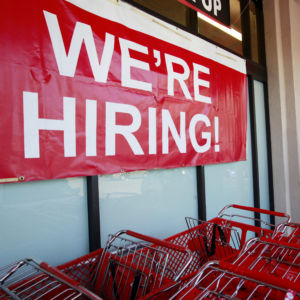The economy saw slower but positive employment growth with the labor market gaining an additional 138,000 new jobs for the month of May, according to a federal report Friday.
Monthly gains over the past year have typically seen greater job growth closer to 200,000. The recent growth has come as welcome news, but lingering issues from the last recession are still prompting concerns. The Bureau of Labor Statistics found in its latest jobs report that recent job growth remains steady, but below what it typically has been.
“Total nonfarm payroll employment increased by 138,000 in May, and the unemployment rate was little changed at 4.3 percent,” the report states. “Job gains occurred in health care and mining.”
The monthly jobs report for March found the labor market only grew slightly with an additional 98,000 new jobs. That slow increase was followed by a much strong jobs report the next month. Monthly employmment growth over the past 12 months has averaged around 181,000 new jobs.
The Great Recession was sparked by the subprime mortgage crisis and the financial crisis of 2007. Former President Barack Obama oversaw the recovery throughout his entire time in office. President Donald Trump inherited a greatly improved economy, but now he faces the challenges still lingering from the collapse.
“We’re in a situation where we’ve never been before, which is to say we just got out of the worst economic downturn since the Great Depression,” Joe Minarik, director of research at The Conference Board, told InsideSources. “We have been trying to exit this period of long and quite modest economic growth.”
The Conference Board is a business membership and research nonprofit. The group represents roughly 1,200 public and private corporations within 60 countries. It conducts economic and business management research and publishes reports which track various economic trends.
Minarik adds that more severe economic downturns tend to be followed by slower recoveries. The Great Depression, for instance, was followed by a recovery that didn’t end until World War II. Minarik notes current economic growth just isn’t robust enough to get the the country fully passed the last recession.
“On the one hand if you look at the headline unemployment rate number you see an unemployment rate that is very low,” Minarik said. “You’d expect with a low unemployment rate you’d have most of the working age population rushing out to go to work. There’s a number of reasons why that didn’t happen.”
The labor force participation rate tracks the number of employed or actively seeking work as a percentage of the total population. Labor market participation has been in decline for decades, but the last recession caused that trend to accelerate.
Georgetown University Prof. Nicole Smith notes that the labor market is still in a very good position despite the issues that have persisted. Smith currently serves as the chief economist for the Georgetown University Center on Education and the Workforce.
“It’s a little bit disheartening,” Smith told InsideSources. “We’d expect to have better participation of anyone who is willing and able to find jobs. But if you look on the flip side, the unemployment rate, the percentage of people that are actively seeking jobs, we are quickly heading towards, or found, full employment.”
The issue is those out of the labor force who are working age and physically able. The labor market has regained most of those losses in recent years. The employment-to-population ratio for prime age adults has been steadily approaching where it was before the recession.
Smith adds wages are a likely reason why people have been unwilling to reenter the labor market. The Pew Research Center found in a 2014 report that wage growth for most workers has flat-lined since 1964 when adjusted for inflation. The jobs report found average wages increased by four cents to $26.22 in the month of May.
“With full employment, there is a tightening of the labor market,” Smith said. “It’s good for workers when we have full employment because it means workers are in a position of power. They are able to, perhaps, request higher wages.”
The Gross Domestic Product (GDP) has also seen lackluster growth recently. GDP tracks the total dollar value of all goods and services produced over a specific time period. The Bureau of Economic Analysis (BEA) found in its advance estimates April 28 that it only increased by 1.2 percent annual rate in the first quarter of 2017.
The health care industry saw the most significant increase of new jobs at 24,000. It was followed by mining, business services, and the food service industry. The jobs report does not include farm workers, private household employees or nonprofits.

